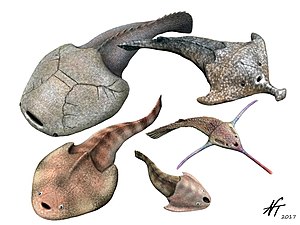Galeaspida
| Galeaspida | ||||||||
|---|---|---|---|---|---|---|---|---|

Live reconstruction of various Galeaspida: Hanyangaspis guodingshanensis (top left), Sanchaspis megalorostra (top right), Lungmenshanapis kyangyouensis (right), Shuyu zhejiangensis (bottom right) and Laxaspis qujingensis (bottom left) |
||||||||
| Temporal occurrence | ||||||||
| Silurian to Devonian | ||||||||
| 430 to 370 million years | ||||||||
| Locations | ||||||||
|
||||||||
| Systematics | ||||||||
|
||||||||
| Scientific name | ||||||||
| Galeaspida | ||||||||
| Liu , 1965 |
The Galeaspida are extinct jawless , fish-like vertebrates that lived in the Silurian and Devonian . Fossils of this very diverse group were often found in China, Tibet and northern Vietnam in marine sediments deposited near the coast , as well as in deposits from lagoons and estuaries. They were likely endemic to the region .
features
The animals had a mostly flattened body and a head armored by a massive shield. At the front in the middle of the shield there was an opening through which the breath water and odorous substances were likely to flow in. The eyes were wide apart at the edge of the head armor. The lateral sensory fields typical of the Osteostraci are missing, but the Galeaspida have an extensive system of sensory channels. The number of side gill openings on the underside was often very large, up to 24 on each side. The mouth was also on the underside. The back of the body was covered with small scales. The shape of the back of the body, including the caudal fin, is largely unknown. There were no other fins other than the caudal fin.
Systematics
A total of about 70 species of Galeaspida have been scientifically described , the two main clades, the Eugaleaspidiformes and the Polybranchiaspidida ("Polybranchiaspidiformes", Huananaspidiformes) are assigned. Hanyangaspis , Dayongaspis and Xiushuiaspis are basal forms.
The Eugaleaspidiformes and the Polybranchiaspidida are sister groups and have a single, transverse sensory channel as synapomorphism . The three basal genera have two such channels as the Heterostraci and the Thelodonti . The Eugaleaspidiformes have a horseshoe-shaped head shield and a slit-like central basal opening. Like basal galeaspida, they only have six to eight gill openings. The polybranchiaspidida have many gill openings (10 to 45). They are divided into the probably basal and paraphyletic "Polybranchiaspidiformes", which had an oval head armor, and the Huannanaspidiformes, whose head shield was characterized by long lateral outgrowths.
literature
- Hans-Peter Schultze: Galeaspida , page 193 in Wilfried Westheide & Reinhard Rieger : Special Zoology Part 2: Vertebrae and cranial animals , 1st edition, spectrum Akademischer Verlag.
- Joseph S. Nelson : Fishes of the World . John Wiley & Sons, 2006, ISBN 0-471-25031-7 .
- Robert L. Carroll: Paleontology and Evolution of the Vertebrates . Thieme, Stuttgart 1993, ISBN 3-13774-401-6 .
- John A. Long: The Rise of Fishes . Johns Hopkins University Press, 1995, ISBN 0801849926 .
Web links
- Janvier, Philippe: 1997. Galeaspida . Version 01 January 1997. in The Tree of Life Web Project
